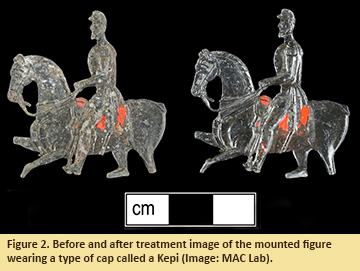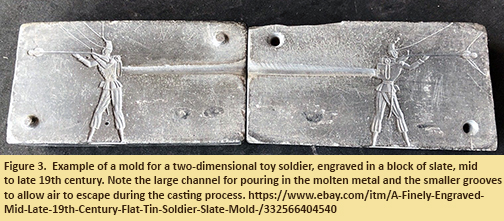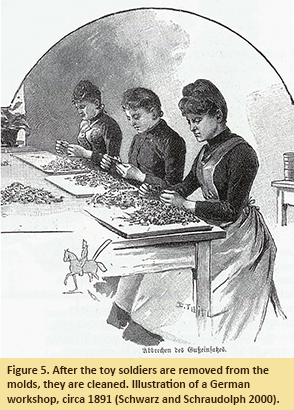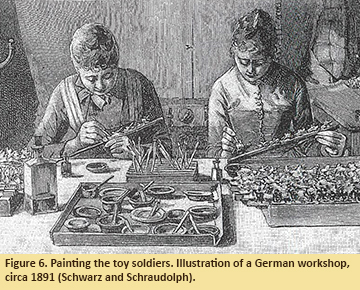Curator's Choice 2018
Toy Soldiers on Parade
April 2018
By Francis Lukezic, MAC Lab Conservator
 Small figurines can trace their origins to the prehistoric and ancient world. Miniature, martial-themed figures made of metal have been unearthed at archaeological sites throughout the world, representing individuals such as Roman infantrymen, Norse Valkyrie, medieval mounted knights, and 18th-century standard bearers (Ortmann 1974; Forsyth and Egan 2005). Marching in the footprints of history, cultural resource management firm AECOM recently excavated five, two-dimensional toy soldiers from a brick-lined privy shaft at a site in Philadelphia, along Interstate-95 (Figure 1) (Kutys 2018). AECOM has been conducting the excavation for the Pennsylvania Department of Transportation and the U.S. Department of Transportation Federal Highway Administration. The military figures have temporarily encamped at the MAC Laboratory while they undergo conservation, as soil and corrosion obscured some of the soldiers’ and horses’ fine details and remnants of red colored paint still present on the surface required stabilization (Figure 2).
Small figurines can trace their origins to the prehistoric and ancient world. Miniature, martial-themed figures made of metal have been unearthed at archaeological sites throughout the world, representing individuals such as Roman infantrymen, Norse Valkyrie, medieval mounted knights, and 18th-century standard bearers (Ortmann 1974; Forsyth and Egan 2005). Marching in the footprints of history, cultural resource management firm AECOM recently excavated five, two-dimensional toy soldiers from a brick-lined privy shaft at a site in Philadelphia, along Interstate-95 (Figure 1) (Kutys 2018). AECOM has been conducting the excavation for the Pennsylvania Department of Transportation and the U.S. Department of Transportation Federal Highway Administration. The military figures have temporarily encamped at the MAC Laboratory while they undergo conservation, as soil and corrosion obscured some of the soldiers’ and horses’ fine details and remnants of red colored paint still present on the surface required stabilization (Figure 2).
 The figures wear uniforms resembling those worn during the American Civil War, which were styled after the uniforms being worn by European armies in the mid-19th century (Kutys 2018; Lukezic 2018). These type of two-dimensional toy soldiers are referred to as ‘flats,’ and in the German language are called zinnfiguren (tin figures) or zinnsoldaten (tin soldiers). As their German names imply, the ‘flats’ are likely made of tin or a metal alloy that includes tin. Flat, tin soldiers began as a child’s plaything in the 18th century and were one of the first mass-produced toys. Prior to that, toy soldiers had been primarily made for and used by royalty, aristocrats, and generals to study and plan military strategy or were collected for their artistic qualities. They were made in workshops throughout Europe, but the pewter-working artisans of Germany dominated the manufacture and export of the toy soldiers (Ortmann 1974). The Bavarian towns of Nuremberg and Fürth, in particular, were a center of production during the 18th, 19th, and 20th centuries and were home to several workshops that created intricately detailed tin figures and other toys in large quantities (Schwarz and Schraudolph 2000).
The figures wear uniforms resembling those worn during the American Civil War, which were styled after the uniforms being worn by European armies in the mid-19th century (Kutys 2018; Lukezic 2018). These type of two-dimensional toy soldiers are referred to as ‘flats,’ and in the German language are called zinnfiguren (tin figures) or zinnsoldaten (tin soldiers). As their German names imply, the ‘flats’ are likely made of tin or a metal alloy that includes tin. Flat, tin soldiers began as a child’s plaything in the 18th century and were one of the first mass-produced toys. Prior to that, toy soldiers had been primarily made for and used by royalty, aristocrats, and generals to study and plan military strategy or were collected for their artistic qualities. They were made in workshops throughout Europe, but the pewter-working artisans of Germany dominated the manufacture and export of the toy soldiers (Ortmann 1974). The Bavarian towns of Nuremberg and Fürth, in particular, were a center of production during the 18th, 19th, and 20th centuries and were home to several workshops that created intricately detailed tin figures and other toys in large quantities (Schwarz and Schraudolph 2000).
 To create a toy soldier, a mold had to be made first. The molds were constructed from two smooth, polished blocks of slate (Figure 3). The artisan would create a drawing of the figure and then transfer the outline of the figure to one of the slate blocks. Hand tools, such as a burin, would then be used to engrave and render the figure in to the slate. Soot was deposited over the engraved mold and then pressed firmly against the smooth, uncut surface of the second part of the mold. This accurately transferred the image of the figure on to the second part of the mold so as to match and coordinate with the first part of the mold. The corresponding image was
To create a toy soldier, a mold had to be made first. The molds were constructed from two smooth, polished blocks of slate (Figure 3). The artisan would create a drawing of the figure and then transfer the outline of the figure to one of the slate blocks. Hand tools, such as a burin, would then be used to engrave and render the figure in to the slate. Soot was deposited over the engraved mold and then pressed firmly against the smooth, uncut surface of the second part of the mold. This accurately transferred the image of the figure on to the second part of the mold so as to match and coordinate with the first part of the mold. The corresponding image was  then hand carved. Once the figure of the soldier was engraved, channels were carved in to the molds for casting purposes. A channel was cut for pouring in the liquid metal and smaller grooves were added to allow air to escape, so as to avoid the formation of bubbles and other casting flaws (Ortmann 1974; Lukezic 2007).
then hand carved. Once the figure of the soldier was engraved, channels were carved in to the molds for casting purposes. A channel was cut for pouring in the liquid metal and smaller grooves were added to allow air to escape, so as to avoid the formation of bubbles and other casting flaws (Ortmann 1974; Lukezic 2007).
To cast the toy soldier, the two-part mold was pressed firmly together, pre-heated, and the molten metal alloy poured in to the channel (Figure 4). Once the metal cooled, the toy soldier was removed from the mold and cleaned. Cleaning included removing excess metal, such as casting sprues, from the figure and using files to finish the edge or surface (Figure 5). The final step was painting the figures (Figure 6). Well cared for molds could have a long working life and be used to cast thousands of toy soldiers (Ortmann 1974).
 Three-dimensional plastic toy soldiers may be more prevalent and popular now. However, workshops in Germany have maintained their long tradition of pewter-working and the flat, metal toy soldiers are still available and made by craftspeople there today.
Three-dimensional plastic toy soldiers may be more prevalent and popular now. However, workshops in Germany have maintained their long tradition of pewter-working and the flat, metal toy soldiers are still available and made by craftspeople there today.

| References |
| Forsyth, Hazel and Geoff Egan |
| 2005 |
Toys, Trifles & Trinkets: Base Metal Miniatures from London 1200 to 1800. Museum of London. Unicorn Press: London. |
|
| Kutys, Thomas |
| 2018 |
Personal Communication- AECOM. |
|
| Lukezic, Craig |
| 2007 |
Pewter Toys from the Roosevelt Inlet Shipwreck. The Bulletin of the Archaeological Society of Delaware 44: 45-64. |
|
| 2018 |
Personal Communication- Delaware State Historic Preservation Office. |
|
| Ortmann, Erwin |
| 1974 |
The Collector’s Guide to Model Tin Figures. G.P. Putnam’s Sons: New York. |
|
| Schwarz, Helmut and Erhard Schraudolph |
| 2000 |
Paradestücke: Zinnfiguren aus Nürnberg und Fürth. Museen der Stadt Nürnberg/ Spielzeugmuseum. W. Tümmels: Nürnberg, Germany. |
|